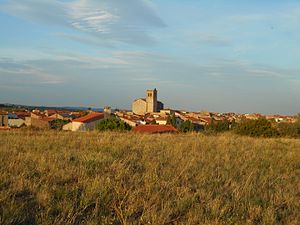Baixas
| Baixas | ||
|---|---|---|

|
|
|
| region | Occitania | |
| Department | Pyrénées-Orientales | |
| Arrondissement | Perpignan | |
| Canton | Le Ribéral | |
| Community association | Perpignan Méditerranée Métropole | |
| Coordinates | 42 ° 45 ′ N , 2 ° 49 ′ E | |
| height | 51-312 m | |
| surface | 18.91 km 2 | |
| Residents | 2,573 (January 1, 2017) | |
| Population density | 136 inhabitants / km 2 | |
| Post Code | 66390 | |
| INSEE code | 66014 | |
| Website | Baixas | |
 Baixàs - town view |
||
Baixas ( catalan Baixas ) is a southern French city and a municipality with 2,573 inhabitants (as of January 1 2017) in the department of Pyrenees-Orientales in the region of Occitania in the historic province de Roussillon .
Location and climate
The place Baixas is about 11 km (driving distance) northwest of the city center of Perpignan at an altitude of about 35 m ; the Mediterranean coast is about 25 km away. The climate is temperate to warm; Rain (approx. 585 mm / year) falls mainly in the winter half-year.
Population development
| year | 1800 | 1851 | 1901 | 1954 | 1999 | 2016 | ||
| Residents | 1,337 | 2.132 | 2,600 | 1,753 | 2,217 | 2,546 | ||
| Source: Cassini and INSEE | ||||||||
The phylloxera crisis and the increasing mechanization of agriculture led to a lack of jobs in the first half of the 20th century and, as a consequence, to a significant decline in the population. The resurgence of the population since the 1960s is mainly due to its proximity to the greater Perpignan area.
economy
For centuries the residents lived on the yields of their fields and gardens as self-sufficient ; Surplus could be sold in Perpignan. Today the community is located in the traditional wine-growing regions of Rivesaltes and Côtes du Roussillon or Côtes du Roussillon-Villages ; at the beginning of the 20th century phylloxera destroyed almost all grapevines. The wines produced here may be marketed under various appellations .
history
The old fortified town of Baissare is mentioned for the first time in 901; A city wall is mentioned as early as 925, but in 928 it came under the manorial rule of the Elne Monastery - a condition that would last until the outbreak of the French Revolution . The disputed area of Roussillon between the French crown and the Kingdom of Aragón belonged to the Kingdom of Mallorca from 1229 to 1344 , then again to Aragón or Spain; in the Peace of the Pyrenees (1659) the final affiliation to France was agreed.
Attractions
- The Église de la Nativité-de-Notre-Dame is the main church of the place. Built in the 12th century, renovations continued into the 18th century. The bell tower (clocher) with its crenellated wreath makes a defensive impression. The church has been recognized as a monument historique since 1982 . In 1674 the church was given one of the largest and most beautiful baroque altars in southern France.
- Essential parts (tower, gates, walls) of the medieval city fortifications (remparts) have been preserved.
- Surroundings
- The Sainte-Catherine hermitage, located about 2 km outside the village , was built in the 15th century.
Personalities
- Andrzej Szpilman (* 1956), composer, now lives in Baixas
Web links
- Baixas - Photos + Info (French)

